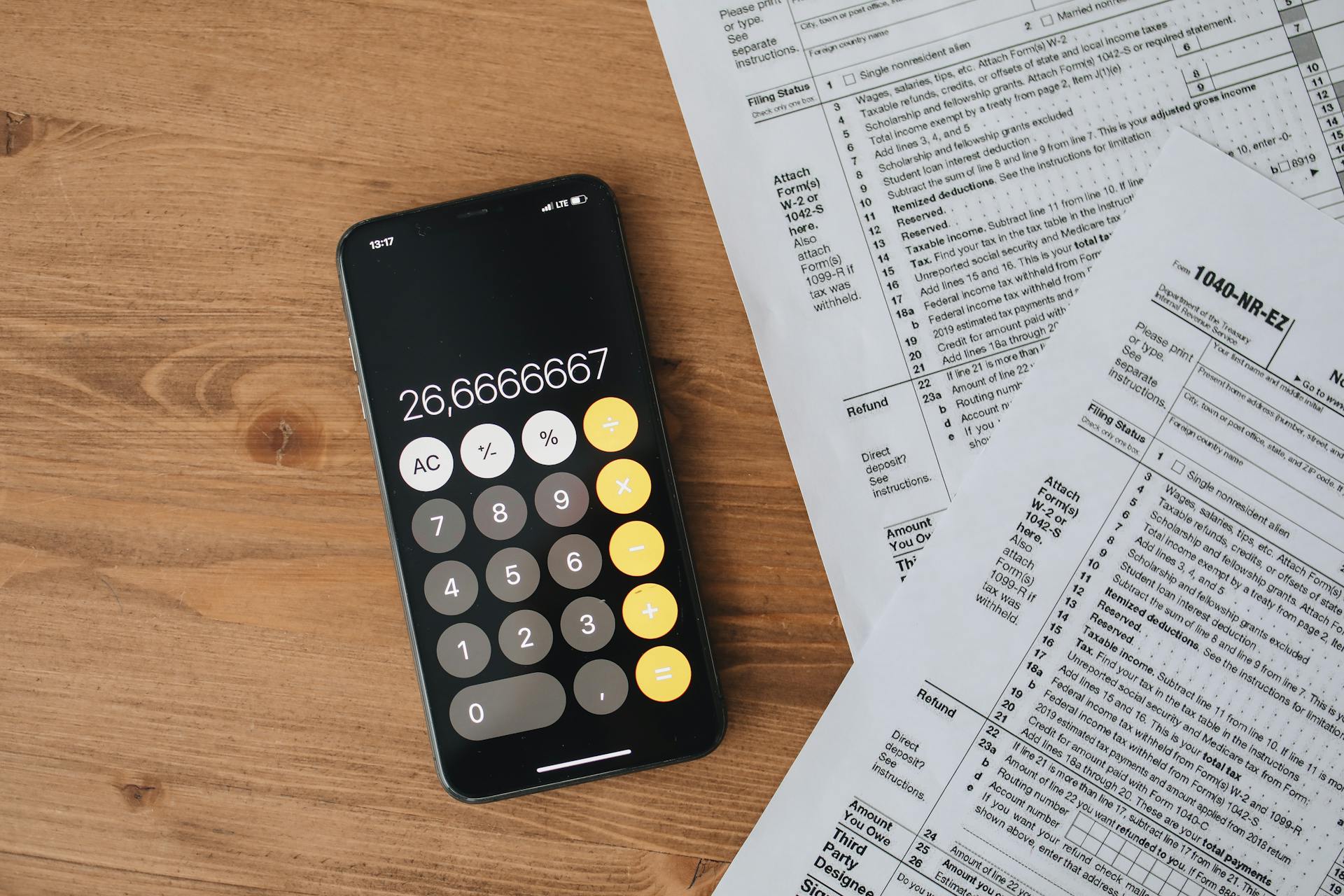
Indirect business taxes are a crucial aspect of a company's financial landscape. They can be a significant expense, and understanding how they work is essential for business owners and accountants alike.
Indirect taxes are levied on goods and services, rather than individuals or businesses directly. This means that the tax burden is passed on to the consumer through higher prices.
Businesses can be subject to various indirect taxes, including sales taxes, value-added taxes (VAT), and excise taxes. These taxes can be complex, with different rates and regulations applying depending on the jurisdiction.
What Are Indirect Business Taxes?
Indirect business taxes are a type of tax that's not directly charged to consumers, but rather to businesses or individuals who produce goods or services that are subject to the tax.
VAT, or Value-Added Tax, is a universal example of an indirect tax, where businesses charge VAT on the value they add to goods or services, and then claim back the VAT they've paid on their own purchases.
There are many types of indirect business taxes beyond VAT, including excise taxes, which are taxes on specific goods such as gasoline, tobacco, and alcohol.
Some examples of excise taxes include taxes on fuel, which can range from 10 to 50 cents per gallon in different countries.
Indirect business taxes can be complex and vary widely depending on the jurisdiction, but understanding them is essential for businesses to stay compliant and competitive.
Types of Indirect Business Taxes
Indirect business taxes can be complex, but let's break it down. There are several types of indirect taxes, including excise taxes, which are imposed on specific goods or services like cigarettes, alcohol, and soda.
Excise taxes are typically higher than standard sales tax and may be imposed at the state and local levels. Some excise taxes are even referred to as "sin taxes" because they're applied to products traditionally deemed "sinful".
We also have goods and services tax, or GST, which is a type of value-added tax applied to some goods and services. Like sales tax, it's collected by the manufacturer or seller and remitted to the government.
You might like: S Corp Business Taxes
Goods and Services Taxes
Goods and Services Taxes are a type of value-added tax applied to some goods and services. They are collected by the manufacturer or seller and remitted to the government.
The consumer ultimately pays the GST, as manufacturers and retailers incorporate the cost into the price of the good or service. This is similar to how import duties or tariffs work, where the price of the goods is increased to pay the relevant tariffs.
The United States does not currently use Goods and Services Tax, instead using federal, state, and local sales tax on goods and services to generate revenue. This means that in the US, you won't see GST on your receipts.
Goods and Services Taxes are similar to sales tax in that they are collected by the manufacturer or seller and remitted to the government. However, they are a type of value-added tax, which means they are applied at each stage of the production process.
You might like: What Type of Business Is Doordash for Taxes
Sales Taxes
Sales taxes are a type of indirect tax that is collected by businesses and remitted to the government. Businesses may increase the purchase price of goods to try to recoup some of the losses they face paying taxes.
There are various types of sales taxes, including Value-Added Tax (VAT) and Goods and Services Tax (GST), although the United States does not currently use GST. Instead, it uses federal, state, and local sales tax on goods and services to generate revenue.
Some sales taxes are applied to specific goods or services, such as excise taxes on retail goods like cigarettes, alcohol, and soda. Excise taxes are typically higher than standard sales tax and may be imposed at the state and local levels.
Sales taxes can be easily collected at the point of sale, reducing the time and cost required by tax authorities to collect taxes. This makes it easier for the government to generate revenue and reduces the effort burden on consumers.
Discover more: What Are Sate and Local Taxes on Utility Business
To find local sales tax rates, you can use the Sales Tax Rate Locator to search for sales tax rates by address. The locator provides information on city rates, county rates, transit rates, special purpose district rates, and more.
Here's a breakdown of the types of sales tax rates you can find using the Sales Tax Rate Locator:
- City Rates with local codes and total tax rates
- County Rates with local codes and effective date
- Transit Rates with local codes and effective dates
- Special Purpose Districts (SPD) Rates with local codes and effective dates
- Combined Area Rates with local codes and effective dates
- Quarterly Updates to Rates and City Annexed Areas
- Local Sales Tax Rate History
Financial Transaction Taxes
Financial transaction taxes are levied on every transaction involving certain financial products like stocks and bonds.
The tax is usually charged as a percentage of the asset's value and must be paid at the time of the transaction.
Federal and state governments can impose financial transaction taxes, typically requiring the seller to pay the tax.
Financial transaction taxes are usually levied as a percentage of the asset's value, making them a significant cost for businesses and investors.
The seller is typically responsible for paying the financial transaction tax, which can add up quickly in high-value transactions.
How Indirect Business Taxes Work
Indirect business taxes are a type of tax that's levied on businesses, but ultimately paid by someone else. This can be a manufacturer, a consumer, or even another business.
The government collects revenue through indirect taxes, which are essentially fees levied equally upon taxpayers. Excise duties on fuel, liquor, and cigarettes are examples of indirect taxes that are commonly used to generate revenue.
Indirect taxes work by shifting the cost from an individual or entity to another group, often resulting in higher-end prices for the goods and services being taxed. Admission fees to a national park are another example of direct taxation, where the person paying the tax is the one immediately paying it.
Recommended read: Paying Corporate Taxes
How It Works
Indirect business taxes are levied on manufacturers, but the cost is passed down to consumers through final price adjustments. This means that even though the tax is levied against the manufacturer, the consumer pays for it.
Excise duties on fuel, liquor, and cigarettes are examples of indirect taxes that are shifted from one group to another. The person earning the income is not the one paying the tax, as is the case with direct taxes like income tax.
Indirect taxes result in higher-end prices for the goods and services being taxed, which can deter consumers from making purchases. This can impact the economy by reducing consumption of these goods and services.
The government collects revenue through indirect taxes, such as the value-added tax, which is imposed on manufacturers. To reduce the strain on lower-income consumers, jurisdictions may reduce or eliminate indirect taxes on essential goods like groceries.
Indirect taxes are essentially fees that are levied equally upon taxpayers, no matter their income. Rich or poor, everyone has to pay them, as seen with excise taxes on fuel and liquor.
For more insights, see: Unrelated Business Income Taxes
How Businesses Offset Costs
Businesses may increase the purchase price of the goods you buy with a sales tax to try to recoup some of the losses they face paying taxes.
This strategy is a way for businesses to offset the cost of taxes, but it ultimately passes the burden on to consumers.
Some businesses may also try to minimize their tax liability by optimizing their accounting and financial planning.
This can involve taking advantage of available tax credits and deductions, or restructuring their business operations to reduce taxable income.
By doing so, businesses can reduce the amount of taxes they owe, which can help offset the costs associated with paying taxes.
Additional reading: How to Reduce Business Taxes
Frequently Asked Questions
What is the difference between direct and indirect taxes?
Direct taxes are paid directly to the government, while indirect taxes can be passed on to others, such as consumers or businesses. This key difference affects who ultimately bears the tax burden.
Who pays for indirect taxes?
Indirect taxes are ultimately paid by the consumer, who absorbs the tax through the cost of goods and services. The supplier or manufacturer passes on the tax to the consumer, making them the final payer.
Featured Images: pexels.com


